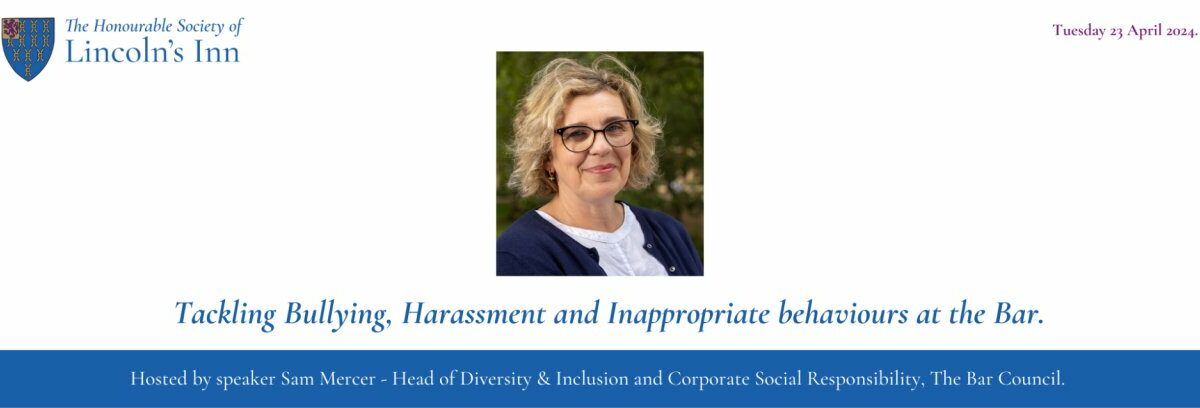
Commercial Awareness Update – W/C 29th April 2024
April 29, 2024
Addressing the Gender Pay Gap in Law
April 30, 2024By Freya Fredriksson.
Reading time: three minutes.
On Tuesday 23 April, I attended a webinar on ‘Tackling Bullying, Harassment and Inappropriate behaviours at the Bar’ which was hosted by the Bar Council. I had the opportunity to listen to the Head of Diversity and Inclusion at the Bar Council, Sam Mercer, who gave an inspiring presentation on this topic and how we can – and must – do better.
What is harassment and bullying?
Harassment is unwanted conduct which has the purpose or effect of violating the victim’s dignity or which creates an intimidating, hostile, degrading, humiliating or offensive environment for the victim (Equality Act 2010). It is also covered in law by acts such as:
- the Sex Discrimination Act;
- the Race Relations Act;
- the Disability Discrimination Act; and the
- Criminal Justice and Public Order Act.
Behaviour that constitutes harassment can be sexist or sexual comments regarding someone’s appearance, overly familiar behaviour or invading someone’s personal space. Whilst harassment is defined in legislation, bullying is not. However, ACAS describes it as ‘offensive, intimidating, malicious or insulting behaviour, an abuse or misuse of power through means intended to undermine, humiliate, denigrate or injure the recipient’.
Examples of bullying may include:
• Shouting at someone;
• Being sarcastic towards, ridiculing or demeaning someone; and
• Overbearing or intimidating levels of supervision.
The difference between harassment and workplace bullying is that harassment is often physical and the victim is targeted due to their individual differences whereas workplace bullying is often more psychological and the target is discriminated against because they are competent or popular (University of Southampton).
Law and regulation
Section 26 of the Equality Act 2010 covers sexual harassment more in detail. This means people can use this legislation without fear as they are protected if they either bring a complaint or a witness to a situation of sexual harassment.
In terms of regulation at the Bar Council, the Bar Standards Boards have listed 10 core professional duties expected of barristers of which the following three are the most relevant in terms of harassment and bullying:
• Core Duty 3: You must act with honesty and integrity.
• Core Duty 5: You must not behave in a way which is likely to diminish the trust and confidence which the public places in you or in the profession.
• Core Duty 8: You must not discriminate unlawfully against any person.
The Courts and Tribunals Judiciary have outlined a statement of expected behaviour called the Judicial Statement of Expected Behaviour. It implies that we should all treat others fairly and respectfully, be mindful of the authority we have and be careful not to abuse it and be aware of how our words and behaviour can affect others.
The Barristers’ Working Lives is a survey of the Bar which questioned self-employed and employed barristers in the UK.
The 2021 report found that:
• More than half of female barristers at the criminal Bar (54%) had experienced bullying, harassment and discrimination in-person or online.
• Barristers from non-White backgrounds were around twice as likely as White barristers to have experienced bullying, harassment, and discrimination.
• Nearly half (45%) of barristers who reported they have a long-term disability said they have experienced bullying, harassment, and discrimination, compared with 27% of those with no disability.
These shocking statistics highlight that there is still change to be done. An interesting point that Mercer made is that perhaps there is not more judicial bullying, but it is rather because more people are better equipped to speak out whilst others are more willing to help tackle and deal with bullies.
Available support
Talk to Spot is an AI service that offers advice and support for anyone at the Bar to record and report inappropriate behaviours so they can build a picture of common behaviours and their impact on the profession. It is completely anonymous unless you disclose your identity. Even if it isn’t taken into formal reporting to a body like the BSB or JCIO, every report helps to fight and tackle bullying and harassment.
Next steps
To tackle bullying and harassment at the Bar, the Bar Council’s Review 2024/5 highlighted that we must change the culture, stop asking for more evidence and accept we have a problem. We must be effective bystanders and most importantly, improve reporting processes/support for those making a report but most importantly, be able to recognise that we have failed if it gets to the stage of a report in the first place.
Additional resources
• IBA report – useful background on harassment and bullying in the legal profession.
• Bullying, harassment and discrimination at the Bar 2023 –Bar Council’s Barristers’ Working Lives.
• Workplace Culture Survey (LPMA/IBC) 2023 – chambers employees’ experiences.
• Lincoln’s Inn Equality, Diversity and Inclusion Survey Report 2023
• Wellbeing at the Bar (bullying and advice and support)
• Lawcare (free & confidential helpline providing wellbeing & mental health support), T: 0800 2796888
• Bar Council Guidance for chambers re sexual harassment
• Talk to Spot (Barristers & Judges)
• BSB Guidance re reporting requirements (Barristers)
• Judicial Conduct Investigations Office (Judges)





